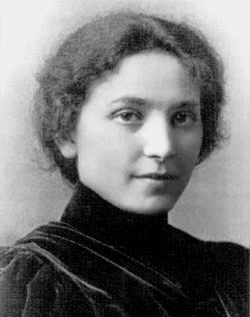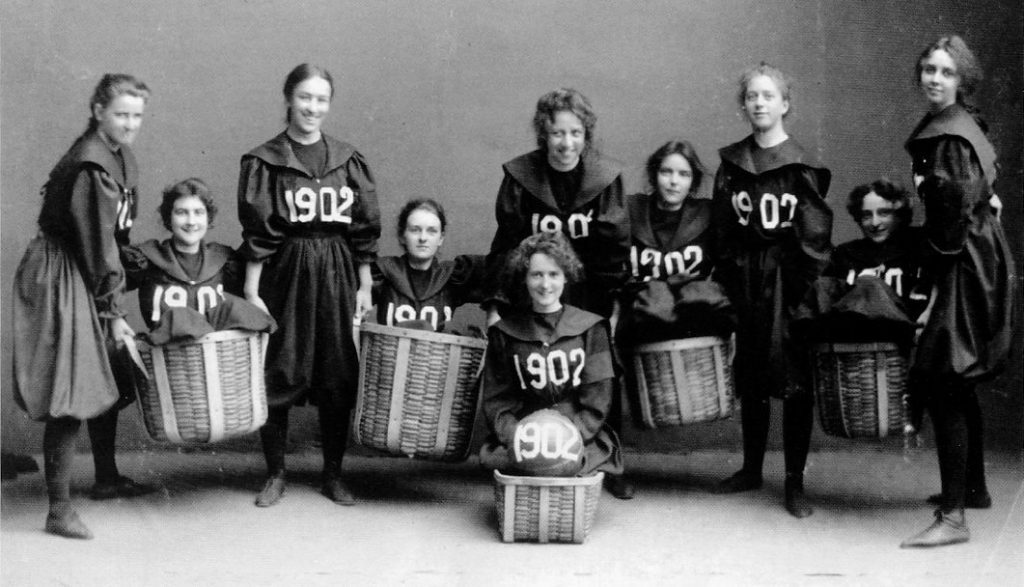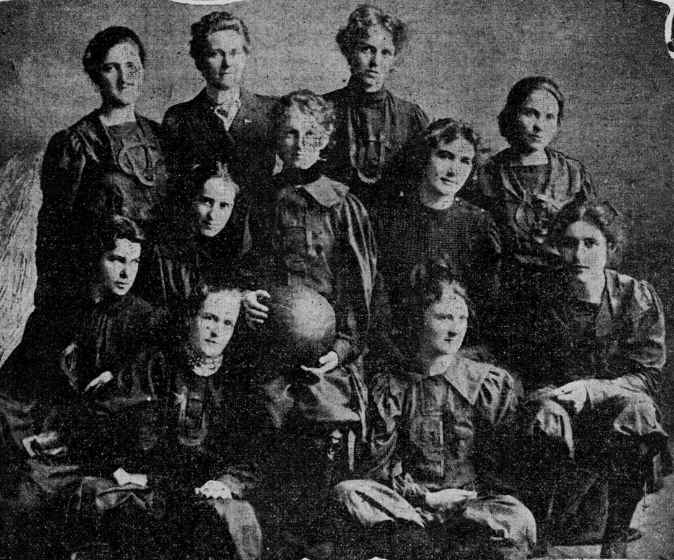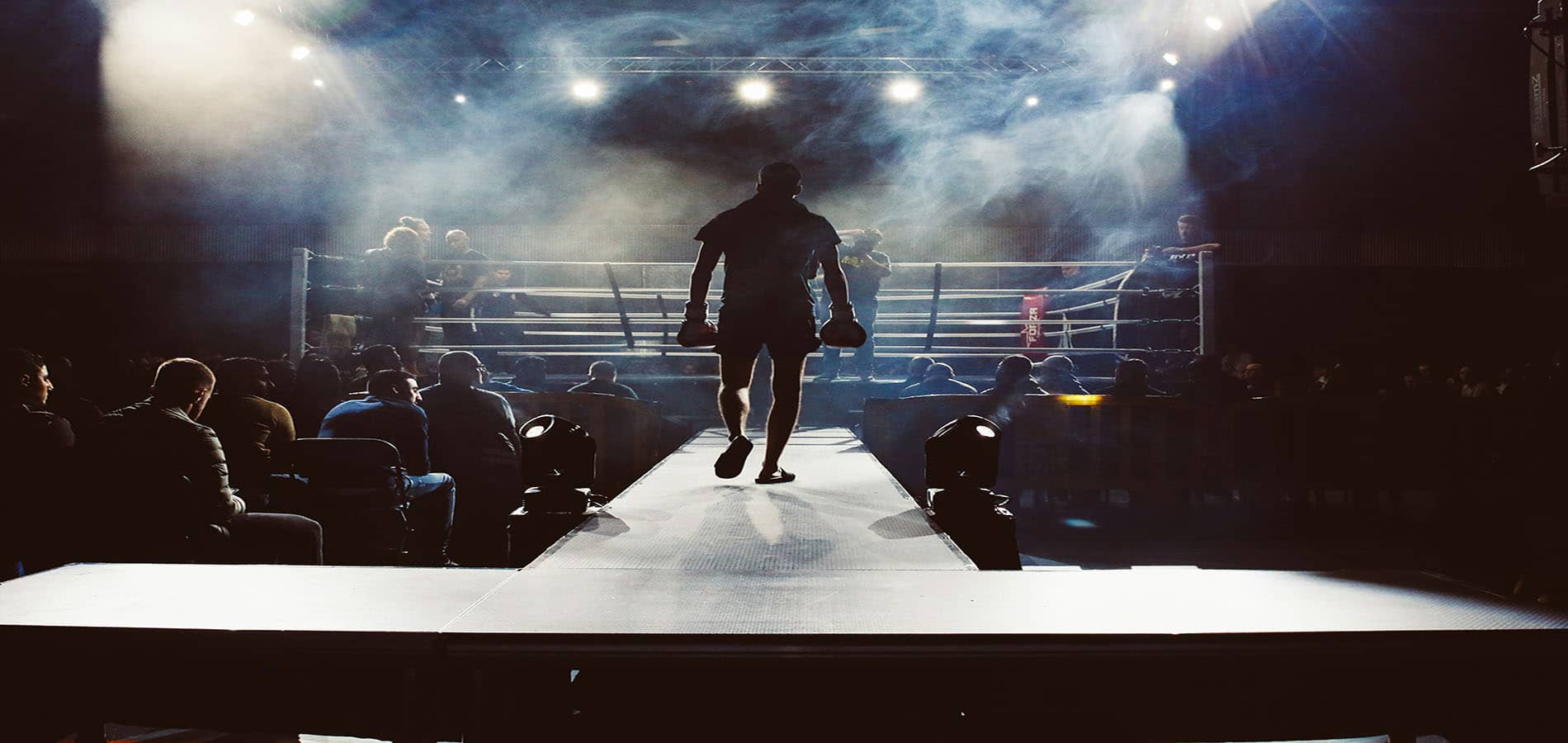Today, women basketball players rack up points on the court, make impossible shots, and play thrilling games just as much as men do. However, it took a long time to get here—the first women playing basketball were doing so in floor-length dresses and corsets. In honor of March Madness and Women’s History Month, we’re using HeinOnline, and especially our Business and Legal Aspects of Sports and Entertainment (BLASE) database, to alley-oop into the fascinating history of women’s basketball.
Nothing But Net? Not Yet.
The game of basketball was invented in 1891 by James Naismith,[1]Pamela; Shackelford Grundy, Susan. Shattering the Glass: The Remarkable History of Women’s Basketball (2007). This article can be found in HeinOnline’s BLASE database. a YMCA physical education instructor in Springfield, Massachusetts, in an attempt to find an indoor activity for kids to participate in during the brutal Northeastern winters. Senda Berenson,[2]Pamela; Shackelford Grundy, Susan. Shattering the Glass: The Remarkable History of Women’s Basketball (2007). This article can be found in HeinOnline’s BLASE database. the physical culture director at Smith College, would bring the new game to the women at her school in 1892. Berenson was concerned that women’s “frailty” and poor health would contribute to their receiving lower wages in comparison to men at a time when women were beginning to enter the workforce. Therefore, she brought basketball to Smith to help the students improve their stamina and physical ability.

However, “nervous fatigue” from the intensity of games was still a real concern, so Berenson adjusted the rules to make the game more ladylike. For example, the court was split into three sections,[3]Pamela; Shackelford Grundy, Susan. Shattering the Glass: The Remarkable History of Women’s Basketball (2007). This article can be found in HeinOnline’s BLASE database. and each player was assigned to a section in order to minimize movement. Additionally, women were only allowed three dribbles, three seconds of holding the ball, and were forbidden from grabbing or hitting the ball away from another player[4]Lyn Lemaire, Women and Athletics: Toward a Physicality Perspective, 5 HARV. WOMEN’s L.J. 121 (1982). This article can be found in HeinOnline’s Law Journal Library.—all attempts to make the game more appropriate according to the standards for “proper” women at the time. However, the sport still drew a significant amount of outrage.

(wo)Man-to-(wo)Man
The first extramural basketball game was between University of California-Berkeley and Anna Head School for Girls in 1892. By the following year, women were playing basketball at Mt. Holyoke College and Sophie Newcomb College[5]Pamela; Shackelford Grundy, Susan. Shattering the Glass: The Remarkable History of Women’s Basketball (2007). This article can be found in HeinOnline’s BLASE database. as well. By 1895, women were shooting hoops across the country, especially at Wellesley, Vassar, and Bryn Mawr. However, Berenson wasn’t thrilled about the burgeoning competitive spirit amongst her girls—she loved basketball for the health benefits it gave her students, and it was not proper for women to be showing such aggression toward each other. The first intercollegiate women’s basketball game was in April 1896 between Berkeley and Stanford,[6]Pamela; Shackelford Grundy, Susan. Shattering the Glass: The Remarkable History of Women’s Basketball (2007). This article can be found in HeinOnline’s BLASE database. but Stanford would soon after ban intercollegiate competition for women in all sports. There was a growing fear that playing basketball, as well as other competitive sports, would have adverse physical and psychological affects on women athletes.

[Basketball] wasn’t invented for girls, and there isn’t anything effeminate about it…It was made for men to play indoors and it is a game that would send the physician who thinks the feminine organization ‘so delicate,’ into the hysterics he tries so hard to perpetuate.
Making It Rain
Women’s basketball didn’t make too much further headway in the first half of the 20th century, except that women were able to self-govern their games beginning in 1924, and the court was reduced to two sections in 1938. In 1971, women were finally allowed to play full-court games, and with the passage of Title IX[7]To amend the Higher Education Act of 1965, the Vocational Education Act of 1963, the General Education Provisions Act (creating a National Foundation for Postsecondary Education and a National Institute of Education), the Elementary and Secondary … Continue reading within the Education Amendments of 1972, there was a massive increase in the number of women participating in athletics. In 1976, women’s basketball was officially added to the Olympics,[8]Pamela; Shackelford Grundy, Susan. Shattering the Glass: The Remarkable History of Women’s Basketball (2007). This article can be found in HeinOnline’s BLASE database. and two years later, the first professional basketball league, the Women’s Professional Basketball League,[9]Jessica L. Hendrick, The Waiting Game: Examining Labor Law and Reasons Why the WNBA Needs to Change Its Age/Education Policy, 27 MARQ. Sports L. REV. 521 (2017). This article can be found in HeinOnline’s Law Journal Library. was established. The National Collegiate Athletic Association (NCAA) began sponsoring women’s basketball in 1982. And in 1985, Senda Berenson became the first women entered into the Naismith Memorial Basketball Hall of Fame.

The United States women’s basketball team won the Olympic gold medal in 1996,[10]John Gibeaut, Shooting for Parity on the Playing Fields, 83 A.B.A. J. 40 (1997). This article can be found in HeinOnline’s Law Journal Library. the same year that the National Basketball Association (NBA) founded the WNBA[11]Jessica L. Hendrick, The Waiting Game: Examining Labor Law and Reasons Why the WNBA Needs to Change Its Age/Education Policy, 27 MARQ. Sports L. REV. 521 (2017). This article can be found in HeinOnline’s Law Journal Library. with eight teams. Today, the WNBA is the longest-standing major women’s professional sports team league, and hosts 12 teams. And now, the only major differences in rules between men’s and women’s basketball is that the ball used in women’s games is 1 inch smaller in circumference, and the three-point line is one foot closer.
Be sure to celebrate all of the progress in women’s basketball this coming weekend—women’s March Madness begins on Sunday, March 12!
Slam Dunk Your Research with BLASE
HeinOnline’s Business and Legal Aspects of Sports and Entertainment contains more than 1,700 titles dedicated to exploring sports and entertainment law. The editors of the database have subject-coded every title within the database according to specific entertainment- and sports-related topics—including Discrimination in Athletics, Gender, Intercollegiate Athletics, Sexual Harassment and Violence, and more. Additionally, the database features editorialized scope notes and annotations, content from the National Sports Law Institute and the Athlete Agents Acts (NCCUSL), and so much more. Learn more via our webpage or dedicated video!
HeinOnline Sources[+]
| ↑1, ↑2, ↑3, ↑5, ↑6, ↑8 | Pamela; Shackelford Grundy, Susan. Shattering the Glass: The Remarkable History of Women’s Basketball (2007). This article can be found in HeinOnline’s BLASE database. |
|---|---|
| ↑4 | Lyn Lemaire, Women and Athletics: Toward a Physicality Perspective, 5 HARV. WOMEN’s L.J. 121 (1982). This article can be found in HeinOnline’s Law Journal Library. |
| ↑7 | To amend the Higher Education Act of 1965, the Vocational Education Act of 1963, the General Education Provisions Act (creating a National Foundation for Postsecondary Education and a National Institute of Education), the Elementary and Secondary Education Act of 1965, Public Law 874, Eighty-first Congress, and related Acts, and for other purposes., Public Law 92-318, 92 Congress. 86 Stat. 235 (1972). This act can be found in HeinOnline’s U.S. Statutes at Large database. |
| ↑9, ↑11 | Jessica L. Hendrick, The Waiting Game: Examining Labor Law and Reasons Why the WNBA Needs to Change Its Age/Education Policy, 27 MARQ. Sports L. REV. 521 (2017). This article can be found in HeinOnline’s Law Journal Library. |
| ↑10 | John Gibeaut, Shooting for Parity on the Playing Fields, 83 A.B.A. J. 40 (1997). This article can be found in HeinOnline’s Law Journal Library. |



